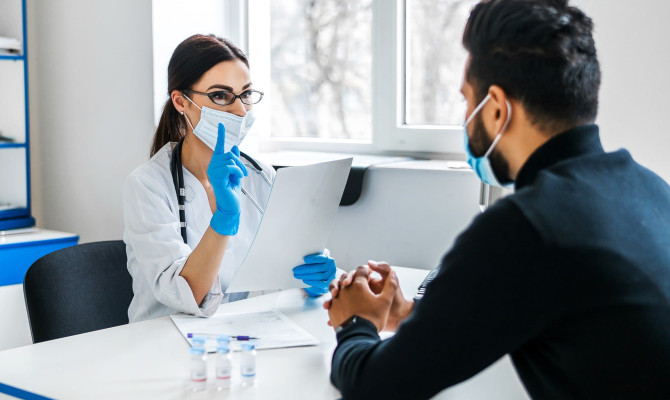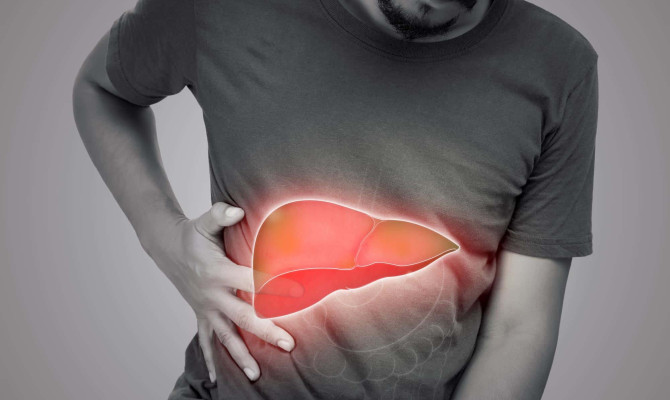Abdominal Pain: A General Overview

- Abdominal Pain
- 14 Aug 2023
Overview
What is Abdominal Pain?
Abdominal pain is a general term for any pain felt between the chest and the groin. The abdomen contains various organs of our body like the liver, gall bladder, duodenum, kidneys, stomach, spleen, pancreas, small and large intestines, appendix, ovaries, ureter, etc. It is a very common complaint and the seriousness could range from getting resolved on its own to some life-threatening conditions.

Types
Types of Abdominal Pain
Abdominal pain could be acute or chronic, based on the intensity and frequency; and could be generalized or localized based on the location of the pain. Also based on the type of pain felt, it could be continuous, intermittent, progressive, sharp, dull, burning, Cramping, or Colicky.
- Generalized – if it is felt all over your belly or tummy. Caused mostly due to indigestion, gas, and irritable bowel disease.
- Localized – if it is not felt all over your abdomen and is only felt over an isolated area of your tummy/belly. For example, if the pain is only felt in your lower left abdomen.
- Continuous type – if the pain exists continuously without any break in between.
- Intermittent kind – if the pain occurs on and off and is not continuous.
- Progressive pain – if the pain worsens with time without any improvement. Examples: Crohn’s disease, enlarged spleen, Hepatitis, lead poisoning, etc.
- Sharp pain in the abdomen – if the pain is felt as a sharp pricking type of pain that is surprisingly painful.
- Dull pain – If the pain is dull and persistent in nature.
- Burning type– Burning type of pain is caused mostly due to acid reflux or acidity in the stomach.
- Cramping– This type of pain usually comes and goes and also changes in severity. Example: Menstrual cramps, endometriosis, Cramping type of abdominal pain after diarrhea.
- Colicky type of pain – if the pain comes in waves, it is said to be a colicky type of pain. Usually starts and ends suddenly. For example, kidney stones.
- Acute abdominal pain – Acute abdominal pain usually develops and often resolves in a few hours or a few days. For example, appendicitis, cystitis, heart attack, etc.
- The chronic type – Chronic abdominal pain may be felt for weeks to months or sometimes even years. A few chronic conditions might be progressive. For example, irritable bowel syndrome, celiac disease, etc.
Symptoms
Associated Symptoms of abdominal pain
Identifying the associated symptoms will help narrow down the diagnosis. Common symptoms include
- Nausea
- Vomiting
- Constipation
- Diarrhea
- Frequent urination
- Painful urination
- The presence of blood or mucous in your stool
- Foul-smelling stool
- Symptoms like fever, chills, tiredness, weight loss, and blood in urine would indicate any type of infection, inflammation, or malignancy. 2symptoms of abdominal pain | Researched based study from nih.gov
Causes
What causes abdominal pain?
We often call abdominal pain, stomach pain or stomach ache, but any pain in your abdomen could mean, pain in any of the organs that the abdomen houses, apart from your stomach. Abdominal pain may be due to a variety of diseases from mild and self-limiting kind of problems (e.g., experiencing acidity in your stomach) to acute and life-threatening problems (e.g., myocardial infarction, acute bowel obstruction, etc.) There are many common reasons for abdominal pain like problems with digestion, inflammatory issues, or pain due to the female reproductive cycle. 1Causes of abdominal pain | Researched based study from nih.gov
Digestive issues include
- Diarrhea
- Vomiting
- Indigestion
- Gas
Inflammatory cause
- Stomach infection by any virus
- Urinary tract infection (UTI)
- Acid refluxes
- Peptic ulcers
Menstrual Cycle
- Menstrual cramps
- Pain during ovulation
- Pain could also be due to food allergies, indigestion, gastritis, food poisoning, Urinary tract infection or other urological causes, menstrual cramps, constipation, kidney stones, intestinal infection, appendicitis, irritable bowel diseases, certain medications, stomach ulcerations, etc.
- The pain could also be from the surrounding muscles and tissues of the abdominal wall. Sometimes it could also be referred to other parts of your body. For example, so many patients complain of pain in their upper abdomen in myocardial infarction.
Locating pain
Locating your Abdominal Pain
Based on the location of the pain, the physician will be able to identify the root cause of your abdominal pain. So, you will have to first identify the location of your pain and describe it to your physician. Even though the location is not the only factor that helps to identify the cause, your physician will want to know more about the pain like its frequency of occurrence, intensity, and severity. There are four distinct areas of your abdomen: the right upper section, the left top portion, the right bottom portion, and the left bottom half. All the organs in your abdomen are inside these four parts as follows:
- Right upper part of your belly: Liver, gall bladder, duodenum, part of the pancreas, adrenal gland & right kidney, a part of your colon that curves near liver, Part of horizontal & ascending colon.
- Left Upper part: Stomach, Spleen, left lobe of the liver, left kidney, adrenal gland, body of pancreas & the part of colon that flexes near spleen, parts of transverse & descending colon.
- The right lower part: Appendix, right ovary & right fallopian tube, part of caecum, right ureter.
- Left lower part of your belly: left ureter, part of descending colon, left ovary and fallopian tube & sigmoid colon.
Diet
Dietary Alterations
- Eat more vegetables and fruits.
- Eat more fibrous food, like sweet potatoes, rolled oats, grains, nuts, etc.
- Add supplemental fiber to your diet. It is hard to believe, that the fibers which are well known for improving constipation, could also help us with the opposite of constipation: diarrhea. But it is accurate. The nutrient aids in preventing the stool from becoming too firm and too loose. It functions in both directions by either absorbing some of the liquid in the bowel to firm up the stools for diarrhea or drawing more fluid from the gut to loosen them for constipation.
- Add probiotic food to your diet. (Probiotics are nothing but the good bacteria or gut needs to maintain its healthy balance)
- Try the low FODMAP diet.
FODMAP Diet
Low FODMAP Diet – An introduction
FODMAP is an acronym for a specific type of carbohydrate called fermentable short-chain carbohydrates, which are more difficult for humans to digest. A low-FODMAP diet temporarily limits these carbohydrates to relieve discomfort and give your digestive system a rest. Removing irritants gives the intestinal lining a chance to repair, helping restore a healthy balance of the intestinal flora. If your symptoms improve, this could also help you figure out which food has to be limited in the future. It is one of many elimination diets that help detect food sensitivities.
Food that has high FODMAP
- Vegetables: Asparagus, Cauliflower, Mushrooms, Green peas, Onions
- Fruits: Apples, Cherries, Peaches, Plums, Watermelons.
- Dairy and alternatives: Milk, Ice cream, Soy milk, Seafood
- Protein sources: legumes, some marinated and processed meat.
- Bread and cereals: wheat, rye, barley-based bread
- Sugars and sweeteners: Honey, sugar-free confectionaries
- Nuts and seeds: Cashews & pistachios
Food that has low FODMAP
- Vegetables: Eggplant, green beans, cucumber, lettuce, potato, tomato, zucchini
- Fruits: Grapes, oranges, pineapples, strawberries
- Dairy and alternatives: hard cheese, almond milk, lactose-free milk, eggs
- Protein sources: Eggs, firm tofu, meats, poultry, seafood, tempeh
- Bread and cereals: Corn flakes, oats, rice cakes
- Sugars and sweeteners: Maple syrup, dark chocolates
- Seeds and Nuts: Peanuts, Pumpkin seeds, macadamias.
Myths
Myths related to abdominal pain
On a lighter note, let us debunk some myths about abdominal pain here.
- People used to think eating spicy food may end up causing stomach ulcers. But now we all know that the bacteria called helicobacter pylori is the culprit here.
- Some NSAIDs also called pain killers could be irritating your stomach lining.
- As we all believed, Beans may not be the biggest reason for producing gas. Compared to other diets, dairy products give you more gas, especially as you become older and lose the ability to fully absorb the sugar (lactose) in milk.
- There is another myth that says smoking relieves heartburn. Nicotine from smoking relaxes the muscles on top of the stomach, as a result, stomach acid keeps splashing back into the esophagus; hence more heartburn and now we have another reason to kick the habit of smoking.
Home remedies
Home remedies to manage abdominal pain

The below listed measures can help you manage mild belly pain brought:
- Drinking plenty of water or other clear fluids frequently to stay hydrated and to help reduce heartburn. (Dehydration makes digestion more difficult)
- Avoid solid food intake for a couple of hours.
- Licorice root may help relieve digestive symptoms.
- Taking enough rest till you feel better.
- Intake of ginger infused water can help in people with vomiting.
- BRAT diet (banana, rice, applesauce and toast- helps soothe the irritated digestive tract.)
- Can try to apply a warm pad to the stomach.
- Avoiding food that are difficult to be digested. (Dairy products)
- Avoiding caffeine.
- Avoiding smoking to decrease heartburn.
- Avoiding alcohol to decrease the heartburn.
- Try relaxation techniques to decrease stress.
- Record your food intake to know what triggers.
Emergency
When should you worry?
Almost everyone would experience abdominal pain at least once in their lifetime, irrespective of their age, sex, or social background. Most of the abdominal pain subsides on its own, but rarely it seems continuous or unbearable and, in such cases, one needs to seek a doctor’s help. In comparison to other symptoms, abdominal pain ranks ninth, among the most frequent reasons for consultation in general practice . If your abdominal pain persists for more than a week or longer and if it does not seem to improve in a day or two or if you have diarrhea for more than two days, you need to check with a nearby physician. Continuous diarrhea can lead to severe dehydration, if left untreated.
Associated life-threatening conditions:
- Abdominal aortic aneurysm -Perforation anywhere along the gastrointestinal tract can be life threatening.
- Acute bowel obstruction
- Acute pancreatitis
- Peritonitis
- Ectopic pregnancy
- Ovarian torsion
- Myocardial infarction.
- If the pain above your belly becomes worse while you exercise, it can be angina or a cardiac arrest
When should you seek a physician’s help?
Diagnosis of abdominal pain is considered very challenging for General Physicians. Sometimes, you might not need to call your physician, if your symptoms disappear without any treatment. Seek a physician’s help if you experience severe abdominal pain due to trauma, such as injury to the abdomen, or pain/pressure in your chest.
If you have the following symptoms, call your doctor:
- Abdominal skin appears unusually yellow.
- Severe tenderness on touching your abdomen
- Unexplained Severe pain
- Pain has spread to your neck or chest
- Makes it difficult to swallow food
- Prolonged pain even after 24 hours
- Pain that wakes you up from sleep
- Pain is getting worse with time
- Repeated nausea and vomiting
- You find blood in your stools
- Enlarged abdomen
- Weight loss
- Being unable to urinate
- Being unable to pass stool
- Being unable to pass gas
- Vaginal bleeding unassociated with your menstrual cycle
- Rectal bleeding.
If you are experiencing severe abdominal pain and it is not associated with any of the above-mentioned symptoms, you might still need to visit a nearby physician.
Diagnosis
How is abdominal pain diagnosed?
When you visit your doctor’s office with abdominal pain, the doctor will take a thorough history, by asking a few questions to understand the severity, onset, nature of discomfort, causative factors, etc. Your doctor may also ask you questions about the nature of your pain, and if you have any underlying physical or mental illness contributing to the pain you feel. The cause is diagnosed based on the systemic history, a physical examination, blood, urine, or stool test if needed.
What are the questions you can expect at the doctor’s office?
- Can you locate the pain?
- How intense the pain is?
- Whether it is dull, stabbing, burning, or cramping kind of pain?
- Whether it is on and off or continuous?
- When are you in pain the most?
- How long have you been feeling this pain?
- Whether it is radiating from any other part of your body?
- Whether any activities seem to make it better or worse?
If you are a female, your doctor may also ask about your menstrual history, any recent injuries, or surgeries performed, history of pregnancy, or if you are currently pregnant and you might have to go through a pelvis examination I needed. Or if you are a male, the doctor might have to examine your penis and scrotum, if needed.
Your doctor might advise you to take up the following tests if you show persistent symptoms.
- Blood test
- Urine culture
- Stool tests
- X-ray of the abdomen
- Ultrasound (USG) of the abdomen
- Computerized tomography scan (CT) of the abdomen
- Endoscopy (wherein your mouth is used to insert a long, thin tube with a small camera into your body.)
- Colonoscopy (one in which a lengthy, flexible tube is pushed into your rectum)
- Colon X-ray
- MRI scan
- ECG
Colon cancer often shows no symptoms before it reaches its later stages, so early detection is very important. Starting at the age of 50, those at moderate risk should begin receiving colon cancer screenings. Every year, fecal testing should be a part of routine colorectal examinations.
Treatment
Treatment for abdominal pain
- In general, it is not recommended to take pain medications without consulting a doctor, as some pain medications can irritate the digestive tract and make the pain worse.
- Once the doctor arrives at a diagnosis, treatment can be initiated for that particular condition.
- Doctors may prescribe drugs that are used to reduce inflammation or affect how organs work to reduce pain.
- Ulcers can be treated by taking drugs that reduce stomach acid production. This helps ensure that food is properly digested. Pain is relieved as the ulcer heals.
- Sometimes the health condition might require a surgical operation to be corrected.
- Pain due to gallbladder inflammation: is usually treated by removing the gallbladder (cholecystectomy). 5Treatment of abdominal pain| Researched based study from nih.gov
- Abdominal pain due to constipation: can be prevented or managed by eating more fibrous food. This also leads to better bowel movements and reduces the long-term risk of colon cancer.
- Eating smaller meals and exercising regularly will also help in the overall health of your abdomen.
- Appendicitis: The appendix is typically removed in order to treat it. Occasionally, medications like analgesics could be prescribed to reduce pain.
- However, common pain relievers such as aspirin and ibuprofen can cause other problems, such as ulcers, so don’t use them without consulting your doctor.
- Doctors may prescribe narcotics for abdominal pain, but their use can cause constipation and other abdominal discomforts.
- Using pain relievers to change the way pain signals are processed in the spinal cord and brain may be another way to treat pain. The most commonly used drugs for this purpose are antidepressants such as trazodone and amitriptyline, which can be taken in very low doses with minimal side effects and little or no antidepressant effect.
- In some circumstances, nerve blocks are used by doctors to manage pain by locating and treating the source of the problem.
- Kidney stones: are mostly treated based on their size, position of the stones, and their accessibility. Without any medical intervention, tiny kidney stones move through your urinary tract. To enable patients, pass the kidney stone, doctors encourage them to consume lots of water. If you are in pain because of a kidney stone, the doctor might prescribe pain killer. Kidney stones that are too large to pass through your urinary tract may give you more pain and you may need treatment immediately. Other invasive methods like cystoscopy, ureteroscopy, shock wave lithotripsy, and percutaneous nephrolithotomy could be performed to remove kidney stones. 4Treatment of Abdominal pain | Researched based study from gi.org
- If the pain is not responding to medications or home remedies, you can try undergoing several supportive therapies to reduce abdominal pain like Cognitive behavioral therapy, hypnotherapy & biofeedback.
Prognosis
Prognosis of abdominal pain
The prognosis of abdominal pain depends on various factors like how long the pain has persisted, and how well the pain is responding to medication. It majorly depends on the underlying cause. Very often the abdominal pain tends to simply get better on its own and might not even need a doctor’s consultation. For instance, pain caused by constipation goes away once the patient passes stool, and pain due to food allergies or intolerances or stomach viruses goes away they get to pass down through the digestive tract.
Takeaway
Key Takeaways
Chronic abdominal pain is a challenging diagnosis that often requires an extensive workup to identify functional or organic conditions, by avoiding excessive investigation. In general practice, a detailed history and a careful physical examination should help the doctors narrow down the list of differential diagnoses and prevent unnecessary testing. Laboratory, endoscopic, and imaging examinations should be recommended in a rational and cost-efficient approach. Regarding the treatment, it is important to assess the risk-benefit ratios and to select dose-appropriate analgesic medication, according to renal and liver insufficiency, dementia and fall risk, and patient tolerance or intolerance of opiates .
Any feedback on this article?
 This Articles content was accurate
This Articles content was accurate Very Informative Article
Very Informative Article I have a question or a comment
I have a question or a comment
 This article contains inaccurate content
This article contains inaccurate content This article was not helpful
This article was not helpful I have a question or a comment
I have a question or a comment
We appreciate your helpful feedback!
Checkout our social pages
References
-
National Institutes of Health
How do health care professionals treat kidney stones? | Overview
-
National Institutes of Health
Studies of the symptom abdominal pain--a systematic review and meta-analysis
-
National Institutes of Health
Chronic Diarrhea: Diagnosis and Management
-
American College of Gastroenterology
Abdominal Pain Syndrome | Kidney stones | Treatment
-
National Institutes of Health
Abdominal Pain in the Geriatric Patient | Treatment






































